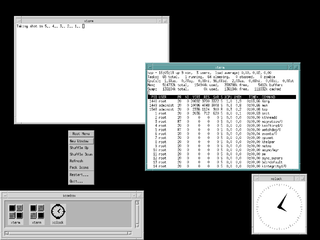The GUI, graphical user interface, is a form of user interface that allows users to interact with electronic devices through graphical icons and audio indicator such as primary notation, instead of text-based UIs, typed command labels or text navigation. GUIs were introduced in reaction to the perceived steep learning curve of CLIs, which require commands to be typed on a computer keyboard.
An integrated development environment (IDE) is a software application that provides comprehensive facilities to computer programmers for software development. An IDE normally consists of at least a source code editor, build automation tools and a debugger. Some IDEs, such as NetBeans and Eclipse, contain the necessary compiler, interpreter, or both; others, such as SharpDevelop and Lazarus, do not.

Lisp machines are general-purpose computers designed to efficiently run Lisp as their main software and programming language, usually via hardware support. They are an example of a high-level language computer architecture, and in a sense, they were the first commercial single-user workstations. Despite being modest in number Lisp machines commercially pioneered many now-commonplace technologies, including effective garbage collection, laser printing, windowing systems, computer mice, high-resolution bit-mapped raster graphics, computer graphic rendering, and networking innovations such as Chaosnet. Several firms built and sold Lisp machines in the 1980s: Symbolics, Lisp Machines Incorporated, Texas Instruments, and Xerox. The operating systems were written in Lisp Machine Lisp, Interlisp (Xerox), and later partly in Common Lisp.
Symbolics was a computer manufacturer Symbolics, Inc., and a privately held company that acquired the assets of the former company and continues to sell and maintain the Open Genera Lisp system and the Macsyma computer algebra system.

Genera is a commercial operating system and integrated development environment for Lisp machines created by Symbolics. It is essentially a fork of an earlier operating system originating on the Massachusetts Institute of Technology (MIT) AI Lab's Lisp machines which Symbolics had used in common with Lisp Machines, Inc. (LMI), and Texas Instruments (TI). Genera was also sold by Symbolics as Open Genera, which runs Genera on computers based on a Digital Equipment Corporation (DEC) Alpha processor using Tru64 UNIX. In 2021 a new version was released as Portable Genera which runs on DEC Alpha Tru64 UNIX, x86_64 and Arm64 Linux, x86_64 and Apple M1 macOS. It is released and licensed as proprietary software.

Maxima is a computer algebra system (CAS) based on a 1982 version of Macsyma. It is written in Common Lisp and runs on all POSIX platforms such as macOS, Unix, BSD, and Linux, as well as under Microsoft Windows and Android. It is free software released under the terms of the GNU General Public License (GPL).

In computing, Motif refers to both a graphical user interface (GUI) specification and the widget toolkit for building applications that follow that specification under the X Window System on Unix and Unix-like operating systems. The Motif look and feel is distinguished by its use of rudimentary square and chiseled three-dimensional effects for its various user interface elements.
Presentation Manager (PM) is the graphical user interface (GUI) that IBM and Microsoft introduced in version 1.1 of their operating system OS/2 in late 1988.

In computing, a visual programming language is any programming language that lets users create programs by manipulating program elements graphically rather than by specifying them textually. A VPL allows programming with visual expressions, spatial arrangements of text and graphic symbols, used either as elements of syntax or secondary notation. For example, many VPLs are based on the idea of "boxes and arrows", where boxes or other screen objects are treated as entities, connected by arrows, lines or arcs which represent relations.

A graphical user interface builder, also known as GUI designer or sometimes RAD IDE, is a software development tool that simplifies the creation of GUIs by allowing the designer to arrange graphical control elements using a drag-and-drop WYSIWYG editor. Without a GUI builder, a GUI must be built by manually specifying each widget's parameters in source-code, with no visual feedback until the program is run. Such tools usually called the term RAD IDE.
A read–eval–print loop (REPL), also termed an interactive toplevel or language shell, is a simple interactive computer programming environment that takes single user inputs, executes them, and returns the result to the user; a program written in a REPL environment is executed piecewise. The term usually refers to programming interfaces similar to the classic Lisp machine interactive environment. Common examples include command-line shells and similar environments for programming languages, and the technique is very characteristic of scripting languages.

In computing, a shell is a computer program that exposes an operating system's services to a human user or other programs. In general, operating system shells use either a command-line interface (CLI) or graphical user interface (GUI), depending on a computer's role and particular operation. It is named a shell because it is the outermost layer around the operating system.
A User Interface Management System (UIMS) is a mechanism for cleanly separating process or business logic from Graphical user interface (GUI) code in a computer program. UIMS are designed to support N-tier architectures by strictly defining and enforcing the boundary between the business logic and the GUI. A fairly rigid Software architecture is nearly always implied by the UIMS, and most often only one paradigm of separation is supported in a single UIMS. A UIMS may also have libraries and systems such as graphical tools for the creation of user interface resources or data stores.
LispWorks is computer software, a proprietary implementation and integrated development environment (IDE) for the programming language Common Lisp. LispWorks was developed by the UK software company Harlequin Ltd., and first published in 1989. Harlequin ultimately spun off its Lisp division as Xanalys Ltd., which took over management and rights to LispWorks. In January 2005, the Xanalys Lisp team formed LispWorks Ltd. to market, develop, and support the software.
Apple Dylan is the original implementation of the programming language Dylan. It was developed by Apple Computer from 1992 to 1995.
Daniel L. Weinreb was an American computer scientist and programmer, with significant work in the environment of the programming language Lisp.
Bernard S. Greenberg is a programmer and computer scientist, known for his work on Multics and the Lisp machine.
A scripting language or script language is a programming language that is used to manipulate, customize, and automate the facilities of an existing system. Scripting languages are usually interpreted at runtime rather than compiled.
McCLIM is an implementation of the Common Lisp Interface Manager (CLIM), for the programming language Common Lisp. The project is named partly after Mike McDonald, the person who began it. It is free and open-source software released under the GNU Lesser General Public License (LGPL) version 2.1.







